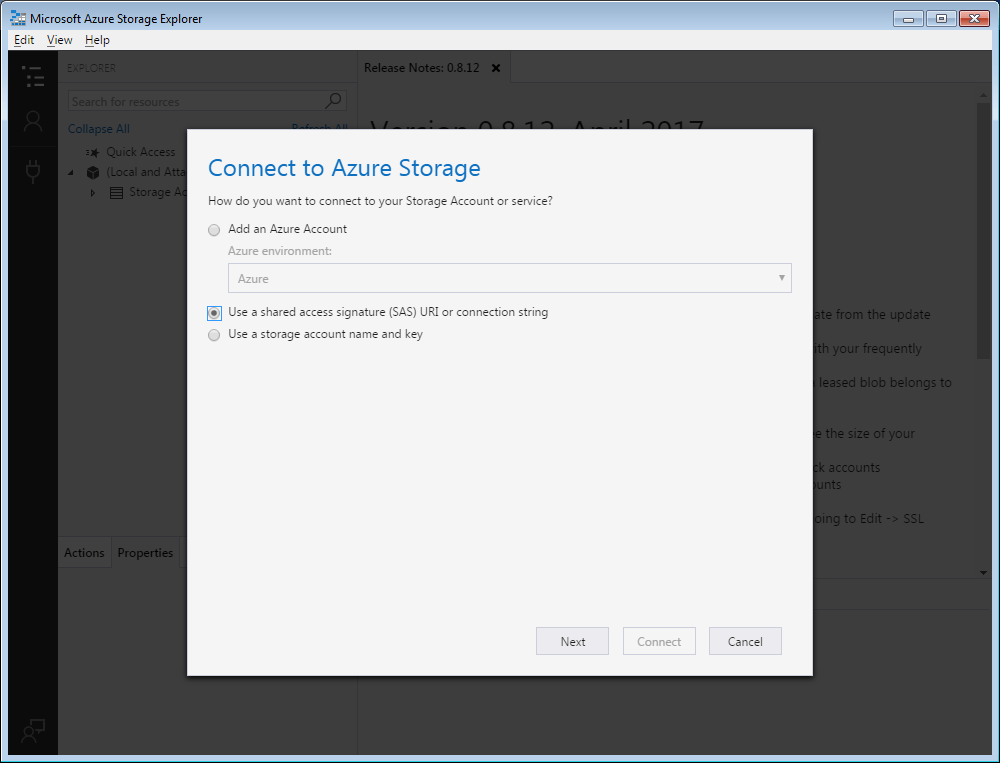This article shows you how to use Azure Storage Explorer to create and manage directories and files in storage accounts that has hierarchical namespace (HNS) enabled.

Azure Storage Explorer helps you upload, download, and manage the data you store in Azure Storage. This month we released version v1.18.0 which includes the following new capabilities: Decrease startup and load time of Storage Explorer. New connection flow to make it easier to specify the type of resource. Easily manage the contents of your storage account with Azure Storage Explorer. Upload, download, and manage blobs, files, queues, tables, and Cosmos DB entities. Gain easy access to manage your virtual machine disks. Work with either Azure Resource Manager or classic storage accounts, plus manage and configure cross-origin resource sharing (CORS) rules. microsoft/AzureStorageExplorer August 2020 (Version 1.15.1, build 20200902.9) Welcome to Storage Explorer version 1.15.1. Azure Storage for Visual Studio Code (Preview) Azure Storage is a Microsoft-managed service providing cloud storage that is highly available, secure, durable, scalable, and redundant. Use the extension to deploy static websites and Single Page Apps (SPAs) and browse Azure Blob Containers, File Shares, Tables, and Queues.
Prerequisites
Format flash drive mac mojave. An Azure subscription. See Get Azure free trial.
A storage account that has hierarchical namespace (HNS) enabled. Follow these instructions to create one.
Azure Storage Explorer installed on your local computer. To install Azure Storage Explorer for Windows, Macintosh, or Linux, see Azure Storage Explorer.
Ms Azure Storage Explorer Download 64-bit
Note
Storage Explorer makes use of both the Blob (blob) & Data Lake Storage Gen2 (dfs) endpoints when working with Azure Data Lake Storage Gen2. If access to Azure Data Lake Storage Gen2 is configured using private endpoints, ensure that two private endpoints are created for the storage account: one with the target sub-resource blob and the other with the target sub-resource dfs.
Sign in to Storage Explorer
When you first start Storage Explorer, the Microsoft Azure Storage Explorer - Connect window appears. While Storage Explorer provides several ways to connect to storage accounts, only one way is currently supported for managing ACLs.
| Task | Purpose |
|---|---|
| Add an Azure Account | Redirects you to your organization's sign-in page to authenticate you to Azure. Currently this is the only supported authentication method if you want to manage and set ACLs. |
| Use a connection string or shared access signature URI | Can be used to directly access a container or storage account with a SAS token or a shared connection string. |
| Use a storage account name and key | Use the storage account name and key of your storage account to connect to Azure storage. |
Select Add an Azure Account and click Sign in.. Follow the on-screen prompts to sign into your Azure account.
When it completes connecting, Azure Storage Explorer loads with the Explorer tab shown. This view gives you insight to all of your Azure storage accounts as well as local storage configured through the Azurite storage emulator, Cosmos DB accounts, or Azure Stack environments.

Create a container
A container holds directories and files. To create one, expand the storage account you created in the proceeding step. Select Blob Containers, right-click, and select Create Blob Container. Enter the name for your container. See the Create a container section for a list of rules and restrictions on naming containers. When complete, press Enter to create the container. Once the container has been successfully created, it is displayed under the Blob Containers folder for the selected storage account.
Create a directory
To create a directory, select the container that you created in the proceeding step. In the container ribbon, choose the New Folder button. Enter the name for your directory. When complete, press Enter to create the directory. Once the directory has been successfully created, it appears in the editor window.
Upload blobs to the directory



On the directory ribbon, choose the Upload button. This operation gives you the option to upload a folder or a file.
Choose the files or folder to upload.
Ms Azure Storage Explorer Download Free
When you select OK, the files selected are queued to upload, each file is uploaded. When the upload is complete, the results are shown in the Activities window.
View blobs in a directory
In the Azure Storage Explorer application, select a directory under a storage account. The main pane shows a list of the blobs in the selected directory.
Download blobs
Azure Storage Explorer App Download
To download files by using Azure Storage Explorer, with a file selected, select Download from the ribbon. A file dialog opens and provides you the ability to enter a file name. Select Save to start the download of a file to the local location.
Next steps
Learn how to manage file and directory permission by setting access control lists (ACLs)
